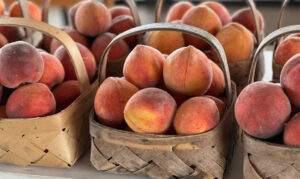I know it’s early in the year, but it’s time. Time to venture once again down to the dark and damp basement, fighting off those pesky spider crickets to retrieve my trusty old soapbox.
It is my duty to stand upon it once again and speak about a grievous error our local grocery store has been committing for years because I can stand it no more.
So what’s got my soon-to-be springtime shorts in a bunch this time? Light red, mealy tomatoes for sale at our local grocery store.
With us five kids growing like weeds, my brothers, The Sister and I ate a lot. To help offset the ever-increasing food bills, Dad always had a garden. Because our backyard was just a few feet away from a swamp, swamp water flooded the garden area anytime there was a heavy rain.
Afterward, the receding waters left a layer of rich black dirt perfect for growing just about anything. Dad grew golf ball-sized radishes, purple beets the size of baseballs, and giant watermelons and cantaloupes on monster vines crisscrossing over a third of the backyard.
The rich dirt in his garden was so fertile, Dad even grew banana trees, but what he was famous for were his ginormous, ruby red, juicy tomatoes. And here, for the very first time, I’m gonna uproot his unique planting technique for all to see.
Most gardeners on Flamingo believed in waiting until after Easter Sunday to plant tomatoes, but Dad always planted his tomatoes mid-March. If asked, any of the other gardeners would probably say that March was way too early to plant tomatoes because of the likelihood of cold temperatures. Not my Dad. Over the years he’d perfected a method of protecting the tender foliage from freezing.
First, he dug a trench for each of the twelve plants. Or I should say, we kids dug the trenches. With five kids, not one ditch was the same, but most were about a foot deep and two feet long. When all the ditches were dug, like the bucket brigades from old, we trekked down to the swamp and waded into the black muck to fill our buckets. It was Dad’s secret ingredient to growing his monster tomatoes. But as important as using the black swamp muck was, what he did next was perhaps even more so.
Dad instructed us to gently pull all the leaves off the tomato plants, leaving the main stem, branches, and only three inches of foliage at the very top. We’d lay the entire plant down into the trench before covering the root ball, stem, and branches with black muck. Then we bent the top three inches of the plant upward so it was the only thing left above ground. He said the stem and branches underground would soon produce a forest of roots, which in return would transfer the rich nourishment from the black muck straight up to his soon prized tomatoes.
Folks not only prized them because they were so juicy and delicious, but Dad actually won prizes. For each of those seven years we lived on Flamingo, his were always the largest and tastiest tomatoes at our county fair.
To keep the tiny plants from freezing, he built miniature green houses over each one with a dome made of screen wire lined with clear plastic.
His mid-March planting method worked each of those seven years we lived on Flamingo. Dad had tomatoes so large that, when sliced, the deep red tomato would cover an entire piece of bread.
It was a special childhood memory, one I’m sad to say I’ve never been able to reproduce. And neither could Dad.
You see, after seven years, we left that house on Flamingo. We left that backyard garden. And we left all that rich black swamp muck. Dad never was able to reproduce that award-winning produce. And though I’ve tried many times during the last fifty plus years, neither have I. But that could be about to change.
The Wife and I were driving around a couple of weeks ago and crossed over a bridge near our house. After all the rain we’ve had lately, water from the creek below had risen over its banks, flooding land on either side. Over a week later, the waters finally receded, leaving behind a familiar-looking expanse of black muck.
Eagerly, I donned my old fire department boots, climbed down and waded into it. I happily scooped up the rich, tomato-growing creek muck, quickly filling a pair of five-gallon buckets.
Could creek muck be as good as swamp muck? Could this be the year I grow Dad’s award winning tomatoes? Perhaps. We’ll just have to wait until the summer for that answer.
Between now and then, I’ll have to be very careful. Growing tomatoes can be extremely dangerous — so dangerous that I haven’t tried in the last seven years.
Seven years ago this summer, a monster-sized tomato grown in my garden ended my twenty-seven-year career as a firefighter. But that story has already been written. I hope this year I can write a much happier, and less painful, story about how my tomatoes won first place at our county fair.
[Rick Ryckeley has been writing stories since 2001. To read more of Rick’s stories, visit his blog: storiesbyrick.wordpress.com.]












Leave a Comment
You must be logged in to post a comment.